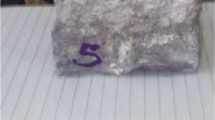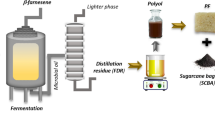Abstract
7075 Al-SiO2 composite foams were successfully produced by using low-cost materials, including as-received pressed blocks of recycled beverage aluminum cans and silica waste particles as a reinforcement and thickening agent. The composite foams were produced by using direct foaming of melt method. Different percentages of foaming agent and SiO2 particles were used to optimize the properties of the produced foams. The compressive behavior at different strain rates of the composite foams was investigated. At all strain rates studied in the present work, the addition of SiO2 particles into 7075 Al foam considerably enhanced the compressive properties of the composite foams, including the compressive plastic stress, plateau stress, modulus of elasticity, normalized modulus, energy absorption and energy absorbing efficiency without increasing in the relative density of the foams. The compressive properties of the composite foam produced by using low-cost materials, in the present work, are comparable or higher than those of the aluminum alloy foams reported in the literature. The composite foams exhibited higher strain hardening exponents in comparison with those of the 7075 Al foams, indicating that a strong interfacial bond between 7075 Al alloy and SiO2 particles was developed. The compressive plastic stress and plateau stress of the investigated foams exhibited a significant sensitivity to altering the strain rate, even at low and narrow range of strain rate used in the present work.
























Similar content being viewed by others
References
M.F. Ashby, A.G. Evans, N.A. Fleck, L.J. Gibson, J.W. Hutchinson, and H.N.G. Wadley, Metal Foams: A Design Guide, Butterworth-Heinemann, Oxford, 2000
K. Yang, X. Yang, E. Liu, C. Shi, L. Ma, C. He, Q. Li, J. Li, and N. Zhao, High Strain Rate Dynamic Compressive Properties and Deformation Behavior of Al Matrix Composite Foams Reinforced by In Situ Grown Carbon Nanotubes, Materials Science and Engineering: A, 2018, 729, p 487–495. https://doi.org/10.1016/j.msea.2017.09.011
I. Duart and J.M.F. Ferreira, Composite and Nanocomposite Metal Foams, Materials, 2016, 9, p 79–113. https://doi.org/10.3390/ma9020079
Y. Du, A.B. Li, X.X. Zhang, Z.B. Tan, R.Z. Su, F. Pu, and L. Geng, Enhancement of the Mechanical Strength of Aluminum Foams by SiC Nanoparticles, Mater. Lett., 2015, 148, p 79–81. https://doi.org/10.1016/j.matlet.2015.02.066
D.K. Rajak, N.N. Mahajan, and S. Das, Fabrication and Investigation of Influence of CaCO3 as Foaming Agent on Al-SiCp Foam, Mater. Manuf. Process., 2018, 33(16), p 379–384. https://doi.org/10.1080/10426914.2018.1532093
S. Vignesh, C. LakshmanaRao, S. Bade, Energy Absorption Characteristics of AA7075-T6 Tube Filled with Aluminum Foam, Advances in Structural Integrity, R. Prakash et al., Ed., Springer, Singapore, 2018, p 303–3013 https://doi.org/10.1007/978-981-10-7197-3_26
D. Yang, J. Chen, L. Wang, J. Jiang, and A. Ma, Fabrication of Al Foam Without Thickening Process Through Melt-Foaming Method, J. Iron Steel Res. Int., 2018, 25, p 90–98. https://doi.org/10.1007/s42243-017-0011-1
S. Yu, Y. Luo, and J. Liu, Effects of Strain Rate and SiC Particle on the Compressive Property of SiCp/AlSi9 Mg Composite Foams, Mater. Sci. Eng., A, 2008, 487, p 394–399. https://doi.org/10.1016/j.msea.2007.11.025
N.V.R. Kumar, N.R. Rao, B. Sudhakar, and A.A. Gokhale, Foaming Experiments on LM25 Alloy Reinforced with SiC Particulates, Mater. Sci. Eng. A, 2010, 527, p 6082–6090. https://doi.org/10.1016/j.msea.2010.06.024
U.A. Atturan, S.H. Nandam, B.S. Murty, and S. Sankaran, Deformation Behavior of In Situ TiB2 Reinforced A357 Aluminum Alloy Composite Foams Under Compressive and Impact Loading, Mater. Sci. Eng. A, 2017, 684, p 178–185. https://doi.org/10.1016/j.msea.2016.12.048
S. Bhogia, J. Nampoothirib, K.R. Ravib, and M. Mukherjee, Influence of Nano and Micro Particles on the Expansion and Mechanical, Properties of Aluminum Foams, Mater. Sci. Eng. A, 2017, 685, p 131–138. https://doi.org/10.1016/j.msea.2016.12.127
J. Banhart, Manufacture, Characterization and Application of Cellular Metals and Metal Foams, Prog. Mater. Sci., 2001, 46, p 559–632. https://doi.org/10.1016/S0079-6425(00)00002-5
E. Kozaa, M. Leonowicz, S. Wojciechowski, and F. Simancik, Compressive Strength of Aluminum Foams, Mater. Lett., 2003, 58, p 132–135. https://doi.org/10.1016/S0167-577X(03)00430-0
A.E. Markaki and T.W. Clyne, The Effect of Cell Wall Microstructure on the Deformation and Fracture of Aluminum-Based Foams, Acta Mater., 2001, 49, p 1677–1686. https://doi.org/10.1016/S1359-6454(01)00072-6
Y. Luo, S. Yu, W. Li, J. Liu, and M. Wei, Compressive Behavior of SiCp/AlSi9Mg Composite Foams, J. Alloys Compd., 2008, 460, p 294–298. https://doi.org/10.1016/j.jallcom.2007.06.041
T. Fukui, M. Saito, Y. Nonaka, and S. Suzuki, Fabrication of Foams of A2024 and A7075 and Influence of Porosity and Heat Treatment on Their Mechanical Properties, Trans. JSME Trans. JSME, 2014, 80, p 1–9. https://doi.org/10.1299/transjsme.2014smm0248
P.H. Thornton and C.L. Magee, The Deformation of Aluminum Foams, Metall. Trans. A, 1975, 6, p 1253–1263. https://doi.org/10.1007/BF02658535
R.E. Raj and B.S.S. Daniel, Aluminum Melt Foam Processing for Light-Weight Structures, Mater. Manuf. Process., 2007, 22, p 525–530. https://doi.org/10.1080/10426910701236072
M.G. Nava, A. Cruz-Ramírez, M.A.S. Rosales, V.H. Gutierrez-Perez, and A. Sanchez-Martínez, Fabrication of Aluminum Alloy Foams by Using Alternative Thickening Agents Via Melt Route, J. Alloys Compd., 2017, 698, p 1009–1017. https://doi.org/10.1016/j.jallcom.2016.12.170
A.V. Byakova, S.V. Gnyloskurenko, A.I. Sirko, Y.V. Milman, and T. Nakamura, The Role of Foaming Agent in Structure and Mechanical Performance of Al Based Foams, Mater. Trans., 2006, 47(9), p 2131–2136
M. Haesche, D. Lehmhus, J. Weise, M. Wichmann, I. Cristina, and M. Mocellin, Carbonates as Foaming Agent in Chip-Based Aluminum Foam Precursor, J. Mater. Sci. Technol., 2010, 26, p 845–850. https://doi.org/10.1016/S1005-0302(10)60135-1
R.M. Aikin, Jr, and L. Christodoulou, The Role of Equiaxed Particles on the Yield Stress of Composites, Scr. Metall. Mater., 1991, 2, p 9–14. https://doi.org/10.1016/0956-716X(91)90345-2
M. Taya, K.E. Lulay, and D.J. Lloyd, Strengthening of a Particulate Metal Matrix Composite by Quenching, Acta Metall. Mater., 1991, 39, p 73–87. https://doi.org/10.1016/0956-7151(91)90329-Y
W.S. Miller and F.J. Humphreys, Strengthening Mechanisms in Particulate Metal Matrix Composites, Scr. Metall. Mater., 1991, 25, p 33–38. https://doi.org/10.1016/0956-716X(91)90349-6
A.P. Roberts and E.J. Garboczi, Elastic Moduli of Model Random Three Dimensional Closed-Cell Cellular Solids, Acta Mater., 2001, 49, p 189–197. https://doi.org/10.1016/S1359-6454(00)00314-1
A. Paul and U. Ramamurty, Strain Rate Sensitivity of a Closed-Cell Aluminum Foam, Mater. Sci. Eng. A, 2000, 281, p 1–7. https://doi.org/10.1016/S0921-5093(99)00750-9
A. Daoud, Effect of Strain Rate on Compressive Properties of novel Zn12Al Based Composite Foams Containing Hybrid Pores, Mater. Sci. Eng. A, 2009, 525, p 7–17. https://doi.org/10.1016/j.msea.2009.05.038
R.J. Arsenault, The Strengthening of Aluminum Alloy 6061 by Fiber and Platelet Silicon Carbide, Mater. Sci. Eng., 1984, 64, p 171–181. https://doi.org/10.1016/0025-5416(84)90101-0
Acknowledgments
This project was supported financially by the Science and Technology Development Fund (STDF), Egypt, Grant No. 25243.
Author information
Authors and Affiliations
Corresponding author
Additional information
Publisher's Note
Springer Nature remains neutral with regard to jurisdictional claims in published maps and institutional affiliations.
Rights and permissions
About this article
Cite this article
Daoud, A., Abou El-Khair, M.T., Fairouz, F. et al. Compressive Behavior of 7075 Al-SiO2 Waste Particle Composite Foams Produced with Recycled Aluminum Cans. J. of Materi Eng and Perform 29, 2978–2990 (2020). https://doi.org/10.1007/s11665-020-04858-y
Received:
Revised:
Published:
Issue Date:
DOI: https://doi.org/10.1007/s11665-020-04858-y




